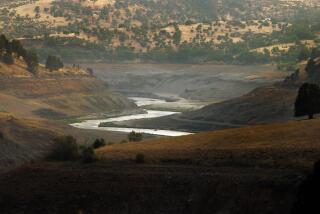Dams add to post-quake danger in China
- Share via
BEIJING — Mao Tse-tung famously declared “man must conquer nature,” and his political heirs have followed his dictum zealously by building dams and other gigantic projects that have altered the landscape of China.
But this month’s deadly earthquake may tilt the balance of public opinion in favor of a more cautious and environmentally conscious approach to such development.
China has more dams than any other country, about half of the world’s total, and the presence of so many near the epicenter in Sichuan province has been a huge complication in the quake’s aftermath. After two weeks of downplaying the problem, the Water Resources Ministry acknowledged Sunday that 69 reservoirs and dams were on the verge of collapse, and nearly 3,000 in China had sustained damage.
The threat of flash floods from dams and “quake lakes” formed from landslides blocking rivers has forced tens of thousands of already traumatized quake survivors to relocate, some more than once. The dams also prevented rescue workers from navigating the rivers to reach victims in areas made inaccessible after roads were washed out.
Many Chinese hold the mystical view that natural disasters are the result of human failings and point to the widespread construction of dams as a possible culprit. The Min River, a tributary of the Yangtze that runs through the path of destruction, is one of the most dammed rivers in the country.
“Chinese ancient culture has a philosophy of a cohesive connection between people and nature. What we did to that river shows no respect for nature, and now nature is taking its revenge,” said Ai Nanshan, a professor of environmental sciences at Sichuan University in Chengdu.
It is not pure superstition. Geologists have long warned of the danger of building dams in earthquake-prone locations. Not only can the structures collapse, but some temblors -- most famously one in 1967 in Koyna, India -- also are believed to have been triggered by the weight of a dam’s reservoir.
“We don’t want to appear to benefit from human catastrophe by pushing an agenda, but we are making information about earthquakes and dams available,” said Peter Bradford, an official with International Rivers Network, a Berkeley environmental group. Bradford said that three people he met on a visit to Beijing this week separately predicted that the Chinese government would reconsider its aggressive dam-building program.
It is too late to stop China’s Three Gorges Dam, the world’s largest hydroelectric power project, which is nearly complete at a cost of $30 billion and more than 1 million people displaced. But environmentalists are likely to use the Sichuan experience to fight controversial plans for a dam for the Nu River in a quake-prone location near the border with Myanmar.
Within days of the magnitude 7.9 quake on May 12, activists scored a big victory when PetroChina announced that it would reconsider its plans for a $5.5-billion refinery and petrochemical plant in Pengzhou, 30 miles from the epicenter. A demonstration early in the month had not appeared to derail the project by China’s largest state-run oil company, and just hours before the temblor, some protest organizers were arrested on charges of inciting unrest.
“You had the earthquake, and everything changed overnight,” said Ai, the professor.
Sichuan province’s environmentalists have been fighting against dams for years. In 2003, they managed to stop a project that was to be built in Dujiangyan on the grounds that it would destroy a 2,000-year-old irrigation system that is a World Heritage Site. (The ancient system, only 20 miles from the epicenter, survived the quake virtually unscathed.)
But they could not block another large project, the Zipingpu dam, which opened two years ago over the objections of the Sichuan Seismological Bureau. The government agency said the dam was too close to a major fault line.
The warnings proved well-founded. Zipingpu’s concrete face sustained severe cracks May 12 even though it was built to the highest quake-resistant standards. Fan Xiao, a geologist in Sichuan who fought Zipingpu, has called for an investigation of whether the dam could have contributed to the temblor.
The area’s Taipingyi and Tongzhong dams also were seriously damaged, Fan said.
Not only did dams crack during the quake, but landslides also damaged hydroelectric power facilities and caused reservoirs to rise to dangerously high levels.
Dams are something of an obsession for the burgeoning Chinese environmental movement. They are at once the most vivid example of Mao’s call to reshape nature and a symbol of greed in the market economy. Most of the dams built in the last decade are to satisfy the nation’s hunger for hydroelectric power and to generate revenue for local governments. Sichuan province (the very name means four rivers), where the rivers rush down from high elevations, is the most tempting location in China for hydropower.
“We have a saying that bridges are silver, highways are gold, and dams are diamonds. If you get a contract to build a dam, there is so much money,” said Dai Qing, a writer who was imprisoned after the Tiananmen Square demonstrations of 1989 and now devotes herself to fighting against the building of dams.
She and others are demanding an investigation of the role of dams in the quake.
“We must look carefully at the questions: How do dams impact earthquakes. How do earthquakes impact dams,” Dai said.
--
More to Read
Sign up for Essential California
The most important California stories and recommendations in your inbox every morning.
You may occasionally receive promotional content from the Los Angeles Times.










